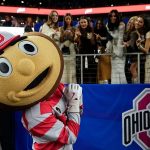
Inside: The changing value of rookie-contract quarterbacks, checking in on a potential Bills holdout and glancing at fantasy football rankings, currently led by Ja’Marr Chase and Saquon Barkley.
This article is from Scoop City, The Athletic’s NFL newsletter. Sign up here to receive it directly in your inbox.
How valuable are rookie QB deals, really?
All we seem to talk about during every NFL Draft season is quarterbacks. It’s understandable — no position in sports has a greater influence on a team’s success.
But the impact of a talented young passer isn’t limited to just his throws and scrambles. Since 2011, rookie quarterbacks have been the best financial value in football.
Advertisement
That year, the new CBA introduced a non-negotiable wage scale for draftees, ending the practice of each No. 1 pick landing a giant contract by leveraging their team’s investment.
Raiders QB JaMarcus Russell remains the poster child for that era, having skipped training camp and Week 1 of his rookie season before the team agreed to a six-year deal worth $61 million. He’d start just 25 career games, making an average of $12.1 million per season as one of the league’s highest-paid players.
Rookie quarterbacks were hit hardest by the 2011 CBA. When the Panthers made Cam Newton the No. 1 pick in 2011, they owed him an average of just $5.5 million per year during his first four seasons — less than half of Russell’s $12.1 million four years prior.
Rookies today still make less than Russell. Despite the league’s salary cap increasing by 156 percent since 2007, whoever is drafted No. 1 in 2025 will make less during his first four years than Russell was making nearly 20 years ago.
That 2011 change immediately altered the nature of team-building, allowing rookie-contract teams to invest more in other positions. These periods, often called “windows,” are why there’s pressure right now in Chicago. A quick glance at Super Bowl QBs still on rookie money:
- 2012: Colin Kaepernick
- 2013: Russell Wilson, won Super Bowl
- 2014: Wilson
- 2018: Jared Goff
- 2019: Patrick Mahomes, won Super Bowl
- 2020: Mahomes
- 2021: Joe Burrow
- 2022: Jalen Hurts
- 2023: Brock Purdy
That’s nine of the era’s 28 Super Bowl starters (32 percent) and six of the past 14 (43 percent). Prior to the 2011 CBA, rookie-contract quarterbacks accounted for just 16 percent of Super Bowl starters.
The benefits of these deals are most obvious when looking at how much of the cap has been taken up by QBs drafted No. 1:
That number has consistently decreased as everything else in the NFL rises.
The difference between Caleb William’s 2025 cap hit ($8.9M) and his likely APY when he’s up for an extension in the summer of 2027? Probably $60 million, at least. (The league’s highest-paid quarterback today is Dak Prescott, who makes $60 million APY, 21.5 percent of the Cowboys’ cap.)
Advertisement
For more on drafting with positional salary-cap value in mind, Austin Mock explains the concept in detail.
If the Titans draft Ward No. 1, he’ll cost roughly a sixth as much as Prescott per year. A team with that kind of extra space could’ve afforded to surround their rookie with WR Davante Adams, C Drew Dalman and OG Will Fries, with money still left over.
That benefit is compounded when you draft a seventh-rounder like Brock Purdy, who made $890,000 while leading the 49ers to the Super Bowl in 2023. Purdy’s salary was so low that it didn’t even count in the team’s cap formula (made up of the 51 highest-paid players on each team).
TLDR: Cheap, young quarterbacks have the potential to lead elite teams. The 77.7 percent discount they offer — when compared to veterans like Geno Smith — is also why Shedeur Sanders and Jaxson Dart will probably be overdrafted in a few weeks.
Scratching that lottery ticket makes sense for any QB-needy team. Maybe you get a Bo Nix. Maybe not. But the NFL’s made sure you’ll never get another JaMarcus Russell.
League meetings ongoing
In what has become one of my favorite rituals, the 2025 NFL head coaches posed for their annual photo (this time minus Raheem Morris):

Nick Sirianni is counting his former assistants’ votes for keeping the tush push like he’s a contestant on “Survivor,” telling NFL Network’s Mike Garafolo:
“All I will say about it is (Jonathan) Gannon, (Shane) Steichen and (Kellen) Moore better vote for it. They are in the (head coach) position right now because of that play. So all three, I better have those three votes right there and the Eagles’ vote. I at least know we have four.”
Wednesdays newsletter will unpack every rule change and the latest on the Steelers’ quarterback situation after HC Mike Tomlin said there’s no deadline for Aaron Rodgers.
Nothing for James Cook in Buffalo
While the Bills made one headline-grabbing addition (former Chargers edge rusher Joey Bosa), the focus this offseason was clear: reward homegrown talent.
From Josh Allen’s record-setting extension to their recent 4-year, $76 million deal with CB Christian Benford, Buffalo committed over $500 million to re-signing its own players.
Advertisement
One notable absence? James Cook. The 25-year-old running back enters the final year of his rookie deal after leading the NFL last season in rushing touchdowns (16) and averaging 90.7 rush yards per playoff game. Cook has made his demand clear: He wants $15 million APY.
Yesterday, GM Brandon Beane told reporters that he does not see them “getting something done anytime soon” with the running back. A few weeks ago, I asked beat reporter Joe Buscaglia: Is Cook part of Buffalo’s long-term future?
💬 I think they’re open to signing Cook long-term, but I’d guess they’re not going to go well overboard on it and want to see what 2025 looks like with him. I don’t think there’s any internal push to trade him right now either. He’s very much a part of their plan this year.
Yesterday, I checked back with Joe. Could the latest update cause any issues, potentially a holdout?
💬 Cook has a great reputation in the building, and they like him a lot as a person. I don’t think we’re at the point where he’s going to cause trouble, but weirder things have happened.
If older brother Dalvin is any indication, expect to see James in pads come August. When Dalvin was in a similar situation as a Viking, he was a possible hold out without an extension in 2020 — but he instead showed up for the team’s offseason activities. He was rewarded for that, receiving a five-year, $63 million extension a few weeks later.
Fantasy football risers
With the draft quickly approaching, Jake Ciely published his list of fantasy winners and losers among key free agents. Jake’s perspective vaulted two big names up my draft boards:
Patriots WR Stefon Diggs: “The Patriots needed a wideout with separation skills, and Diggs still brings it. After posting an 80+ Open Score (ESPN) in every season from 2019-2022, he had a dip in 2023, but bounced back with an 83 last year. For reference, Demario Douglas led the Patriots at 64, with no other wideout over 36. Diggs is a fantasy WR3, with room to return better value if he’s even 90 percent of the player we saw from 2019-22.”
Jets WR Garrett Wilson: “With Davante Adams gone, Wilson has the upside to finish as a WR1 if new QB Justin Fields treats him like he once did DJ Moore. Let’s not forget Moore’s 2023 season (with Fields at QB for 13 games), when he had career highs in yards, touchdowns and fantasy points per game (14.1), finishing as a WR1 overall and in FPPG.”
Jake is also much higher than the consensus on Fields, Seahawks WR Cooper Kupp and 49ers WR Jauan Jennings. You can find his full list of rankings here.
Friday’s most-clicked: Brooks Kubena explains the ongoing war over Houston Oiler blue.
📫 Enjoyed this read? Sign up here to receive The Athletic’s free daily NFL newsletter in your inbox.
Also, check out our other newsletters.
(Photo: Ezra Shaw, Michael Reaves / Getty Images)
This news was originally published on this post .








Be the first to leave a comment